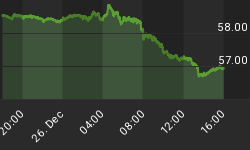A reader pointed out to me today a piece by Amy Higgins and Randal Verbrugge on the Cleveland Fed's website entitled "Is a Nonseasonally Adjusted Median CPI a Useful Signal of Trend Inflation?" I will let readers draw their own conclusions about the new measure that Higgins and Verbrugge are proposing, but I wanted to point out the research because I often cite Median CPI as the best way to look at the central tendency of inflation (what the researchers call "trend inflation") and this article confirms and reinforces that point of view.
And it is worth looking, therefore, at the recent movements in Median CPI. Yes, I know you've seen this over and over from me, but take a look anyway (chart is sourced from Bloomberg).

I don't believe for a second that the FOMC is unaware of this picture; nor, however, do I believe they really care equally about inflation and growth. The talk right now is moderately hawkish, and with growth fair and inflation heading higher it is time to withdraw reserves. Indeed, it is long past time. As I have said for a while, the time to withdraw reserves was roughly when the Fed was busy implementing their last QE. Also note that I am not saying "raise rates," since raising rates is an effect of withdrawing reserves and it is the withdrawal of reserves, not the raising of rates, that matters.
Practically speaking, since growth is slowing, the Fed is now back in a pickle of its own making. Inflation is clearly heading higher; growth is probably heading lower. If the FOMC had a balanced mandate (inflation and employment equal) then they would probably be at a neutral rate right now, so that would argue for tightening. But the FOMC has nothing remotely close to a balanced mandate. Against all evidence that monetary policy can affect inflation but not growth, the Fed is totally biased to act to support growth. The bankers believe that slow growth solves the inflation problem, so they should fight recession and just worry about inflation when growth gets "too hot." Therefore, I currently do not expect the Fed to tighten in December.
Moreover, this increase in core or median inflation is happening in most major economies (with the notable exception of the UK, where it was nearing 4% in 2011 but has gradually come back to around 1%). This is in contrast to the conventional wisdom being propagated that inflation is falling everywhere. Consider the chart below, which is of core Japanese CPI (with the effect of the one-off tax increase in 2014 smoothed out).

Core inflation in Japan is the highest it has been in more than 17 years. Seventeen years. Tell me again how the BOJ's money printing is having no effect? It is having no effect on growth, but it is doing what we would expect it to do on inflation.
Eurozone inflation is rising less impressively (see chart), but still rising. But then, the ECB has been less aggressive on monetary policy than either the US or Japan. Still, Europe is not, as the popular press would have you believe, flirting with deflation.

All of these economies are only flirting with deflation if you include energy quotes (these pictures may be worse if we had median CPI rather than core CPI for these economies). Now, energy quotes matter, just as much when they are going down as when they are going up, but it is a separate question whether including energy is at all helpful for predicting future inflation. And the answer is, as the Higgins and Verbrugge point out: no, it really isn't. We are entering a period with weakening growth and strengthening inflation.
This should be "fun."
You can follow me @inflation_guy!
Enduring Investments is a registered investment adviser that specializes in solving inflation-related problems. Fill out the contact form at http://www.EnduringInvestments.com/contact and we will send you our latest Quarterly Inflation Outlook. And if you make sure to put your physical mailing address in the "comment" section of the contact form, we will also send you a copy of Michael Ashton's book "Maestro, My Ass!"
















